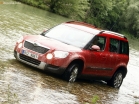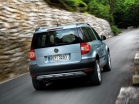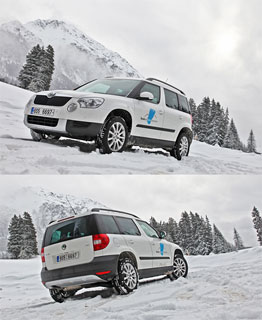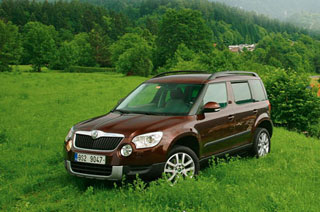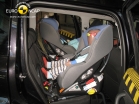Skoda Yeti test drive since 2009 -
I am a Robot! Skoda Yeti 1.8 TSI received dsg
The good news for Yeti fans: Skoda began to accept orders for an all-wheel drive 152-horsepower version of the Yeti 1.8 TSI crossover, equipped with an automatic, pre-sectus gearbox DSG. Initially, the Czechs did not plan to combine a 152-horsepower engine with a machine gun on a cross. Like it or not, the priority market for Skoda Europe, and there they love mainly mechanical transmission.
Mechanics are simpler, easier, a priori is more reliable and cheaper, but in Russia, it is more popular that automatic boxes are more popular. Moreover, so that approximately half of the cars are now sold with this type of transmission.
Meanwhile, the performance with the 1.8 TSI engine is currently the only all -wheel drive variation of the crossover, it is not surprising that buyers require it with an automaton. There is, of course, the ability to order the automatic modification of the yeti with the 105-horsepower 1.2 TSI engine, but it is much less dynamic, and besides, there is only a drive on the front wheels. Also, a diesel 140-horsepower version of the Yeti with all-wheel drive transmission and the DSG robot was also previously available. But the trouble, the quotas this year quickly ended on it, in general, there is no such car on sale. In priority Europe, the demand for her is also mad, so now it is not yet known whether Skoda will give Russia to Russia to sell this modification next year or not.
However, back to our rams. DSG (Direct Shift Gearbox Direct Together Box) is an all -folkswagen automatic robotic gearbox with two multi -disc clutches. It has several advantages compared to the hydrotransformer automatic, of the main ones: high speed, higher efficiency, simple design, smaller size and weight.
Six -speed DSG gearbox diagram with two wet multi -disc cliff
The torque from the engine is supplied to the body in which the clutch is located. Further, depending on which of the clutch is included, the torque is transmitted through the primary shaft, a couple of gears of the corresponding gear, the synchronizer coupling and the secondary shaft for the lead gear of the main gear. In fact, in one DSG block two gearboxes are combined, which work in turn. Clutch, primary shafts, secondary shafts and the leading gear of the main program here by pair. The leading gears of the main transmission of various diameters, and they are hooked with a led gear in different places. In both gearboxes, the transmission is always included, the transition from one to the other is turned off one of the clutch and turning on the other
Certain programs in DSG work with one clutch, odd with another. In the box itself, two steps are always included during movement. One of the clutch is turned off, and through the other included precisely, the power flow from the engine to the drive wheels is transmitted. The transition from one transmission to another is re -singling of clutch, that is, one clutch turns off, the other immediately turns on. This happens with minimal delays and practically without expanding power flow. Switching time 5-8 milliseconds. While the car accelerates at the current stage, the following is in advance in the box. The same thing happens when slowing down, but in the reverse sequence.
DSG is placed on the countless number of VAG concern models, and until recently, it had two options for performing six steps plus a pair of wet clutches and seven gears plus a pair of dry clutches. Now there is a third, more hardy variation of the transmission, in which a seven -speed box is combined with two wet clutches. It is placed on the Audi Q3 (in Audi, such boxes are designated as s tronic).

Cleanses of Yeti 180 mm. For light off -road, not so much. But it is better to meddle in such traps, after checking the relief
A six -speed pre -sequenter box with two wet clutches in combination with the 1.8 engine on Yeti appeared with the filing of the Russian representative office. But not only we will receive a new variation, in the near future the Czechs will offer this version in a number of European Union countries: in themselves, in Germany, Britain, Spain, Italy, Denmark, Sweden, as well as Israel. And next year, Skoda will begin a massive attack on the Middle East and even Australia. Our modifications will start in September, but we have already been able to try the new product in the Sochi roads.
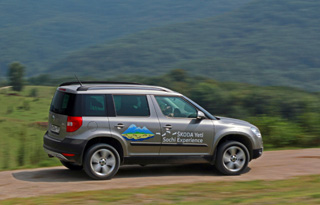
Near Sochi, the roads of different quality, but for the most part, the coating is simply terrifying, it is not without reason that the local jeep-spari in open UAZs in general, a more suitable place for the test of crossovers and SUVs, is arranged for tourists, it is difficult to find for tourists.
On complex off -road, the automatic version behaves no worse than the mechanical one. Although many scold the mechanics for the fact that during touching on heavy ground or mountains, you have to burn the clutch. In general, it is, heavy off -road requires filigree clutch pedal and a shorter first program. With DSG, the situation, in general, is the same (a number of gear numbers in the box and the main gear is identical), but you will not drown out the engine of careless adhesion pedal. At an extreme lift, at the time of touching, the motor roars, yeti rests, but rides, and all due to the fact that electronics can hold DSG'SHY clutch on the verge of slipping for a long time. The smell, by the way, is also worth it to be healthy. But the same variator Qashqai grazes in such conditions, you can’t strip it from its place, the electronics withdraws a belt
And what about the roads? The six -speed robot has already gone the eighth year. I know this box well, from half a year to six months it is getting better and better. Management programs are debugged, the technological process is changing a normal business, in general. And if earlier there were complaints about the smoothness of switching, now the machine is deprived of old problems. The transition from transmission to transmission in mode D is quickly and almost imperceptibly. Previously, DSG was dulled when moving down through the transmission (from a single one to a single or from odd to an odd), now the delays are minimal.
The work is predictable, and I have a complete understanding with this transmission now. In the sports mode, the algorithm for the operation of the power unit changes dramatically the engine freezes at medium high speeds, while the box holds one or two steps lower and everything in order to accelerate with minimal delays. Switching faster with slightly noticeable shocks. And how competently there are overheads when slowing down and lower the reduced ones! In general, there are more than enough speakers in sports. In this case, it is possible to switch the programs manually! I remember that with this box at one time there were problems on Volkswagen, but after adjusting the production technology, the share of clutch failures and mechatronics became insignificant.
We tested Yeti several times, the car was studied along and across, and on Sochi roads it only confirmed its renom. The chassis pleases with its maturity. The suspension for many will be slightly harsh, but not so much as to annoy a strong shaking on rocky roads. On the high -speed line and the Yeti turns, the rolls of moderate are good, and the information content of the steering is great. But the subordination inside the concern is observed by the Audi Q3, built on the same PQ35 platform, has more aristocratic habits, powerful motors, rich decoration and arsenal of options. Although, in terms of additional equipment, Skoda is able to have a lot of nerves to competitors. The system of dynamic stabilization has an all -wheel drive version already in the database, however, only a couple of pillows (and many competitors offer 4 or 6 at once). Side eire beags with curtains, navigation, rear view camera, automatic parking worker, panoramic roof and much, much more, are available for surcharge.
SUNCHOUSE POSSITION is also at the level. The rear wheels in Yeti are connected by command of electronics using a fourth -generation Haldex coupling. It is worth translating the transmission selector to the D or R position, as the electronics selects the gaps and slightly press the clutches of the coupling. A small premitting award allows you to transfer the torque to the rear axle by default (about 5-10%). This reduces the time of blocking the coupling and makes the start more reliable on weak soils: ice, snow, dirt or sand. It is enough to turn to the angle of 5-8 degrees with the front wheels, as the coupling is immediately blocked and will be fully thrust to the rear wheels. Haldex’s performance deserves only praise, on slippery coatings under the gas on the verge of lateral sliding, the nature of the turning of Yeti neutral habits is equipped with a constant symmetrical all -wheel drive.
Thanks to the timely blocking of the hind axis of the coupling and simulating differential locks (their role is played by ABS, selectively branding slipping wheels), the crossover overcomes tangible lifting with diagonally hanged wheels. But he does it a little less confidently than Volkswagen Tiguan and Audi Q3. The transmission of all three is identical, the difference is only in the control algorithms. Tiguan and Q3 posted wheels are practically not allowed to slip, and they climb on much more steep ascents. Yeti is a little weaker here. Subordination again?
And what about efficiency and dynamics? DSG increased the mass by 20 kg and slightly raised the Yeti fuel consumption in the urban mode of 10.6 liters per 100 km versus 10.1 in the version with mechanics. But on the highway, the machine is a little more economical per 100 km of path, it requires 6.8 liters instead of 6.9 with a manual box. In a mixed cycle, 8 liters parity. But on mountain roads and off -road, the consumption increases significantly, and this is natural for me Yeti ate 17 liters per hundred. In dynamics, DSG loses slightly, acceleration to 100 km/h 9 seconds, with a mechanical version of 8.7.
Useful thing Off Road, which is activated by the key. An interesting thing, on all all -wheel drive goy this chip in the base, and on the Audi Q3 it does not even in the list of options. The engine in this mode with the gas pedal responds less willingly, and the speed does not rise above 2.5 thousand. This is done in order to reduce the risk of slipping on slippery coatings. The anti -operating system comes into operation a little later (if desired, it can be turned off at all), and ABS works according to a special algorithm.
The frequency of braking pulses is halved (from 20 Hz to 10 Hz). Due to this, the effectiveness of slowing down the soil and snow above, the wheels in a blocked state are longer and manage to rake up large rollers at the time of blocking that create greater resistance. On ice, braking with spikes is also more effective (spikes work best when there is a prolonged slip of the tire relative to the icy surface). True, controllability during emergency braking with a working ABS with such an algorithm is worse, in fact, that is why Off Road is active at speeds up to 30 km/h.
The Off Road mode also involves a system for helping the mountains. Electronics on a fragmented slope itself will control the trajectory you specified and the speed of descent by selective pulsed brakes of the wheels. The assistant is also interesting in that it works when moving on reversing, and allows gas and brake (even on neutrals) to adjust the descent speed.
A roof of a different color before could only be ordered in Fabia, now it is possible on Yeti. But I remember that the very first concept of the crossover was two -color! Four options for coloring the roof are white, black, silver and beige available. True, for the original color you will have to pay 12 thousand rubles. A panoramic hatch is available as an option
The trunk is replete with a large number of hooks, nets, lapcs. There is a 12-volt outlet. Comfortable! In the underground of Russian Yeti, a full-size 16-inch reserve on a steel disk and an organizer. Range of trunk volumes 405 1760 liters. 405 under the window sill with armchairs completely moved back and back, 1760 with a dismantled rear row
Planting the front riders is slightly vertical. For crossovers, this is rather the norm, but in this a danger lurks, the lower back is more tired on long trips. I want wider ranges of adjusting the steering column. The above is true for both Tiguan and Audi Q3. There is a lot of space behind, a person 190 cm tall herself sits down with a margin.
Among the competitors, Yeti has the best possibilities for transforming the salon. Even the nozzle Volkswagen Tiguan and Audi Q3 in this regard is easier.
The Varioflex Skodov system allows you to use the internal space as efficiently as possible. The rear seat is divided into three segments. The lateral sections move forward/back independently of each other. The backs of the segments can be folded, and then you get a flat cargo platform. You can increase the cargo compartment by folding the seats and putting them vertically close to the front chairs or by dismantling them at all (together or separately). The front passenger chair can be ordered with a folding back.
If you remove the central section, the side chairs can be moved closer to each other. Passengers on shifted armchairs are more volitional, shoulders and knees do not rest on the door, but the riders are deprived of the central armrest with the cup holders
The surcharge for DSG on version 1.8 TSI is 40 thousand rubles. A car in the Russian market in three levels of equipment is proposed: Active (969,000 rubles), Ambition (1,019,000 rubles) and Experience (1,079,000 rubles). And what about competitors? Let's look at the closest Yeti rivals. A full-wheel drive Nissan Qashqai with a two-liter 141-horsepower atmospheric, a variator and all-wheel drive starts with 1,030,000 rubles. In the maximum configuration, such Qashqai costs 1,200,000 rubles. The 150-horsepower Kia Sportage with a 2.0 engine (150 hp), a six-speed automatic and all-wheel drive will cost at least 1,089,000 rubles. Similar Hyundai IX35 costs 1,107,000 rubles. The tempting proposal of Ssangyong Actyon. The Korean crossover with a diesel 175-horsepower engine, a six-speed automatic and all-wheel drive will cost 1,059,000. But in all consumer parameters, it does not reach rivals. Full -wheel drive Mitsubishi ASX with a motor of 150 hp. With the variator in the most affordable performance costs 1,089,000 rubles. If you run through the configurators, Skoda Yeti will be very attractive due to more options offered for comparable money. What a sin to hide, I myself have a weakness for this car. And this is a logical explanation. In terms of controllability of Yeti, it is definitely better than the designated competitors, in dynamics and economy too. If you put functionality at the forefront, then the Czech Czech puts everyone on the shoulder blades with its Varioflex salon. At the same time, Skoda pleases with democratic service prices. So if you look at Yeti, feel free to take it.
Vitaly Kabyshev
Photo: Vitaly Kabyshev and Skoda
Specifications
Body
Type SUV
Engine
Working volume, cm 1798
Power, L.S. at rpm 152 at 4300
Torque, NM at rpm 250 at 15004200
Dimensions, mass, volumes
Length, mm 4223
Width, mm 1793
Height, mm 1691
Wheel base, mm 2578
Clearance, mm 180
Equipped mass, kg 1540
Dynamic characteristics
Acceleration from a place to 100 km/h, from 9.0
Maximum speed, km/h 192
Fuel consumption
Average conditional fuel consumption, l/100 km 8.0
City, l/100 km 10.6
Highway, l/100 km 6.8

Source: Auto.mail.ru
Video test drives Skoda Yeti since 2009
Video crash tests Skoda Yeti since 2009
Skoda Yeti test drive since 2009
Skoda Yeti Crash Test since 2009
Krassh Test: Detailed Information92%
Driver and passengers
46%
Pedestrians
78%
Children-passengers
71%
Active security system
Skoda Yeti malfunctions since 2009
Skoda Yeti malfunctions: Detailed information| Yeti since 2009 | |
|---|---|
| Engine |  |
| Transmission | |
| Control system and suspension |  |
| Brake system |  |
| Air heating and air conditioning |  |
| Launch and charging system |  |
| Electric components and so on |  |
| Corrosion body stability |  |



